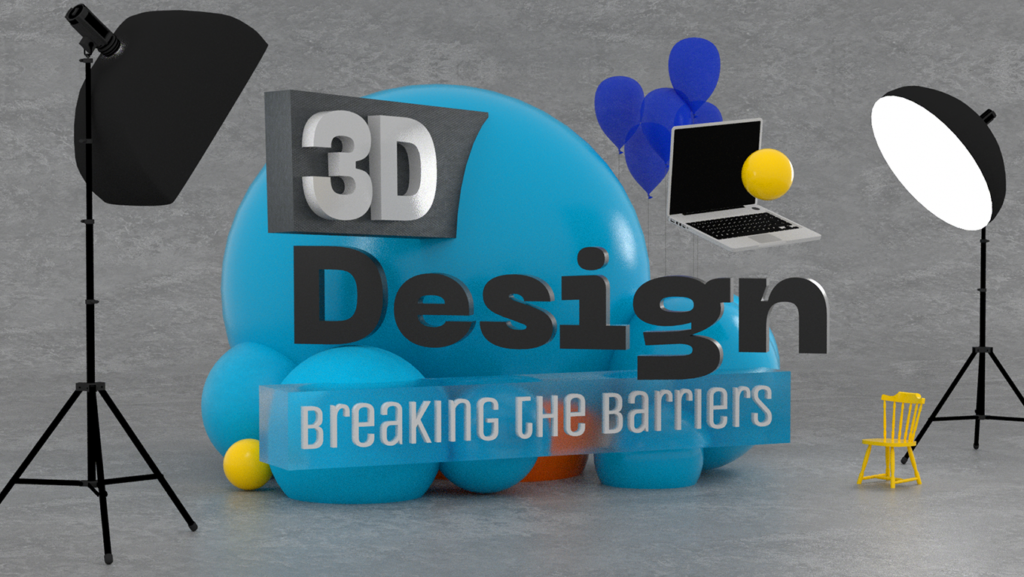Breaking the Barriers of 3D Design

Ten years ago, 3D Graphics of any salable quality would have taken an entire studio of professionals and a huge budget to accomplish.
An abundance of free programs and the lowering cost of hardware now make it possible to go through the entire commercial pipeline with a much more specialized team, and a more realistic budget.
Effects that used to only be possible by teams of a hundred artists are now accessible by smaller teams of skilled designers with decent computers.
Of course, it’s ridiculous to think that fully animated Pixar-quality commercials are now achievable by the masses, those still take large studios and a high skill cap to accomplish.
Adding Dimension to Your Product
The biggest industry use case seems to lie in visualizing products. Short, quick product shots with crisp lighting are showing up everywhere in the industry lately. This works especially well for tech products with reflective surfaces, or products with an abstract component that’s difficult to describe, like the comfortable sole of a running shoe.
Instead of setting up studio lighting, suspending the product, and shooting it on an actual camera for an afternoon, you set up a virtual environment for the shot, and go through the same motions with virtual cameras, lights, and products, all inside your computer.
If the client or Art Director wants a different colour sneaker, or a little less depth of field in one specific shot, you aren’t stuck trying to fix it in post, and you don’t have to spend an afternoon setting up the studio lights again for a lengthy and expensive re-shoot. You simply open the scene, adjust the colour, and let the shot render while you eat your lunch.
Shooting Virtual products makes for a quicker and cheaper adjustment process, with faster iterations and output as a result.
It also benefits from being artificial, so you can do things that would be impossible without camera tricks or post processing. It’s common for tech ads to blow apart the product, show each of the components, then re-assemble it piece by piece.
This process will never be a replacement for the warmth that comes from using real actors, or the authentic nature of shooting on location, but that isn’t the goal here. This type of Motion Graphic design has its own niche, excelling when the main draw is the material itself, or the technology involved in its creation.
Industry Insight
Take Flyknit for example, a new material Nike is making shoes from, as light as it is strong. The main draw is the technology and sophistication of the material. Space age construction. Futuristic. Appealing to emotion won’t work here. How do you market something this abstract?
Go watch their ad. ManvsMachine nailed it. A shoe made of small delicate feathers expands, zooming into the individual fibres of the feather, each of which becomes a steel cable that pulls taut to become the upper half of a shoe.
Abstract. Visceral. You can feel the strength of the material. It somehow becomes more real than real. Sure, the same thing might be achievable by traditional means, but if your client wants any major edits, you’re in for a nightmare of re-shoots.
This style of ad is everywhere now. A Macbook Air falling through virtual silk, a Fender guitar blown apart into its base components, or the entire Air Max campaign of shoe silhouettes filled with various types of bubbles and foam. Sure, MvsM is using expensive, impenetrable software for a lot of this, likely Houdini, but you can achieve more than competent results on cheaper gear.
Architectural Visualization
After Product Visualization comes Architectural Visualization. They go hand in hand. It’s an equally achievable goal for a designer to build a virtual work site and fly a virtual drone through to show a client what a place might look like.
Shifting Landscapes
This process retains the most success by small teams as long as organic and human elements involved stay to a minimum. Animating characters or faces multiply the budget exponentially, & requires an entirely different skill set with highly specialized Artists dedicated to each step — like the Rigger, a person who turns a model into a virtual puppet for the animator to control, an intermediary job between the excitement of the Sculptor and the Animator that’s often overlooked.
The depth of skill involved in animation like this remains out of the wheelhouse of most solo, or even small team Motion Graphics artists, not to mention remaining nearly impossible to edit to the client’s whim without re-doing an entire scene. This isn’t an effective use of anybody’s time in a fast moving industry with tight budgets.
But even this is changing. Auto-rigging software becomes a stand-in for your basic rigging needs. Vast asset libraries and 3D scanning tools take the job of the sculptor. The lowering cost of Motion Capture suits means you can act out the scene yourself at a much lower price tag, a small price to pay for something completely unattainable a short time ago.
Every week a new solo creator blows the lid off what we thought was possible, creating entirely new works with free software and asset libraries, collaging all these resources together into something new and groundbreaking.
The space changes so quickly it’s increasingly true that the ability to be resourceful, and learn new software quickly is the most valuable skill to have.
